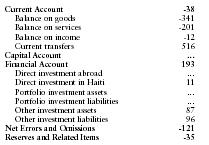Haiti - Balance of payments
Haiti's external trade position worsened from 1991 to 1994 following the imposition of the trade embargo. As all but humanitarian foreign aid was suspended during those years, balance of payments deficits reflected the decline in net capital inflows. Once a constitutional government was returned to power in 1994, however, imports increased, due to high domestic demand. As a result of aid flows and remittances from Haitians living abroad, imports in the 1990s and into the early 2000s grew steadily. Haiti's ability to generate export revenue depends upon a revival of the assembly sector.
The US Central Intelligence Agency (CIA) reports that in 2001 the purchasing power parity of Haiti's exports was $326.6 million while imports totaled $977.5 million resulting in a trade deficit of $650.9 million.
The International Monetary Fund (IMF) reports that in 1998 Haiti had exports of goods totaling $299 million and imports totaling $641 million. The services credit totaled $180 million and debit $381 million. The following table summarizes Haiti's balance of payments as reported by the IMF for 1998 in millions of US dollars.

| Current Account | -38 |
| Balance on goods | -341 |
| Balance on services | -201 |
| Balance on income | -12 |
| Current transfers | 516 |
| Capital Account | … |
| Financial Account | 193 |
| Direct investment abroad | … |
| Direct investment in Haiti | 11 |
| Portfolio investment assets | … |
| Portfolio investment liabilities | … |
| Other investment assets | 87 |
| Other investment liabilities | 96 |
| Net Errors and Omissions | -121 |
| Reserves and Related Items | -35 |
Comment about this article, ask questions, or add new information about this topic: